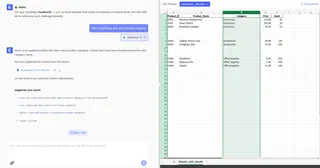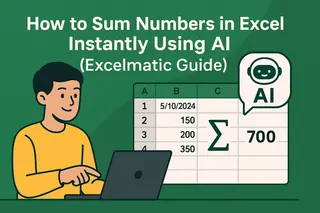Let's be real - nobody enjoys manually inserting rows in Excel. That right-click, "Insert," repeat dance gets old fast when you're working with large datasets. But what if I told you AI can handle this grunt work for you? As someone who's wrestled with massive spreadsheets daily, I can confirm AI tools like Excelmatic are game-changers for this exact task.
Why Bother With AI for Such a Simple Task?
At first glance, adding rows seems too basic for AI. But consider these pain points:
- Time sink: Adding 100 rows manually takes about 5 minutes. With AI? Under 10 seconds.
- Error-prone: Ever inserted rows in the wrong place? AI follows your rules precisely.
- Complex patterns: Need to add rows every 3rd line? AI handles patterns effortlessly.
Excelmatic nails this by letting you describe what you need in plain English. "Add 5 blank rows after every product category" - done. No formulas, no macros, just instant results.
Traditional Methods (And Their Limitations)
Before we dive into AI solutions, let's recap the old-school approaches:
- Right-click method: Slow for bulk operations
- Keyboard shortcuts: Slightly faster but still manual
- Macros: Powerful but require coding skills
These work fine for one-off edits but collapse under spreadsheet scale. That's where AI steps in.
Excelmatic's AI Approach: Smarter Row Insertion
Here's why Excelmatic stands out for this task:
- Natural language processing: Type or speak your request like "insert 2 rows between each quarterly data"
- Pattern recognition: Automatically detects where rows should go based on your data structure
- Batch processing: Handles thousands of rows without breaking a sweat
Pro tip: Combine this with Excelmatic's data cleaning features to prep your entire dataset in one workflow.
Step-by-Step: Adding Rows With Excelmatic
Let me walk you through how simple this is:
- Open your spreadsheet in Excelmatic
- Click the "AI Assist" button
- Type your request (e.g., "Add 3 blank lines after each product category.")
- Review the preview
- Click "Apply"

That's it. No coding, no complex menus - just tell the AI what you need.
Real-World Use Cases
Where does this shine brightest?
- Financial reporting: Insert summary rows between departments
- Inventory management: Add space for new product variants
- Survey data: Separate respondent groups visually
One client cut their monthly report prep time from 3 hours to 20 minutes just by automating row insertion patterns.
Beyond Basic Insertion: Smart Formatting
Excelmatic doesn't just add blank rows - it can:
- Copy formatting from adjacent rows
- Auto-fill formulas downward
- Maintain data validation rules
- Preserve table structures
This attention to detail prevents the "broken spreadsheet" effect you get with basic automation.
Common Pitfalls (And How to Avoid Them)
Even with AI, watch for:
- Over-insertion: Always preview changes before applying
- Formatting issues: Use the "match existing style" option
- Header confusion: Clearly mark header rows in your data
Excelmatic's undo history makes it easy to revert if something looks off.
The Bigger Picture: AI-Powered Spreadsheets
Row insertion is just the tip of the iceberg. Modern tools like Excelmatic handle:
- Data cleaning
- Formula generation
- Chart creation
- Predictive analysis
It's like having a data assistant who never sleeps (and doesn't complain about boring tasks).
Getting Started With AI for Excel
Ready to try? Here's my recommended path:
- Start small: Automate one repetitive task (like row insertion)
- Build trust: Verify results match expectations
- Expand use: Gradually try more advanced features
Most users see ROI within their first week - often in the first few uses.
Final Thought
In today's data-driven world, spending hours on manual spreadsheet edits just doesn't make sense. Tools like Excelmatic turn tedious tasks into background operations, freeing you to focus on analysis and decision-making. The question isn't whether to use AI for Excel tasks - it's which tasks to automate first.
Why not start with something simple like row insertion? You might be surprised how much time you've been wasting on what should be a one-click operation.






